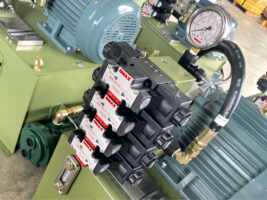COMMON HYDRAULIC COMPONENTS AND THEIR FUNCTIONS
Common Hydraulic Components and Their Functions
Hydraulics is a widely used technology that harnesses the power of fluids to perform various mechanical tasks. It’s a fundamental part of many industrial, automotive, and construction applications. To better understand how hydraulic systems work, it’s essential to familiarize yourself with some common hydraulic components and their functions. In this article, we’ll explore these components and their roles in hydraulic systems.
1. Hydraulic Pump
The hydraulic pump is the heart of any hydraulic system. It is responsible for converting mechanical energy, typically from an electric motor or an internal combustion engine, into hydraulic energy. The primary function of the pump is to generate a flow of pressurized hydraulic fluid, usually oil, to power the entire system.
2. Hydraulic Reservoir
The hydraulic reservoir, also known as a hydraulic tank, is a container that stores hydraulic fluid. It serves several important functions, including storing excess fluid, dissipating heat, and allowing for air and moisture separation from the fluid.
3. Hydraulic Fluid
Hydraulic fluid, often hydraulic oil, serves as the medium for transmitting power in hydraulic systems. It must have the right viscosity, lubricating properties, and temperature resistance to ensure the system’s proper operation.
4. Hydraulic Cylinder
Hydraulic cylinders are vital components that convert hydraulic energy into linear mechanical motion. They consist of a cylinder barrel, a piston, and a rod. When hydraulic fluid is pressurized and introduced into the cylinder, it pushes the piston, which, in turn, moves the attached rod, allowing for linear work to be performed.
5. Hydraulic Valves
Hydraulic systems employ various types of hydraulic valves, such as directional control valves, pressure control valves, and flow control valves. These valves regulate the flow of hydraulic fluid, control the direction of movement, and maintain pressure levels within the system.
6. Hydraulic Hose and Fittings
Hydraulic hoses and fittings are crucial for transferring hydraulic fluid between components. Hoses are flexible and durable, while fittings ensure leak-free connections. Proper maintenance and inspection of hoses and fittings are essential to prevent system failures.
7. Hydraulic Filter
Hydraulic systems must maintain clean hydraulic fluid to function efficiently. Hydraulic filters remove contaminants and particles from the fluid, ensuring the system remains free from debris that can cause damage to components and decrease system performance.
8. Accumulator
Hydraulic accumulators store hydraulic energy in the form of pressurized fluid. They can release this stored energy when needed, providing a quick power source for peak demands, shock absorption, or emergency situations.
9. Hydraulic Motor
Hydraulic motors convert hydraulic energy into rotary mechanical motion. They are commonly used in applications where continuous, high-torque rotation is required, such as in construction equipment and industrial machinery.
10. Pressure Gauge
Pressure gauges are used to monitor and display the pressure levels within the hydraulic system. They help operators ensure that the system operates within safe and efficient pressure ranges.
11. Hydraulic Actuators
Hydraulic actuators are devices that perform work by responding to hydraulic pressure. They include hydraulic cylinders and hydraulic motors, which are essential for moving and controlling heavy loads or performing precise, controlled movements.
In conclusion, hydraulic systems are complex, and understanding the functions of their various components is crucial for their proper operation and maintenance. Whether in heavy machinery, automotive braking systems, or aircraft landing gear, hydraulic technology plays a significant role in many industries, making it essential to comprehend the roles of these common hydraulic components.


